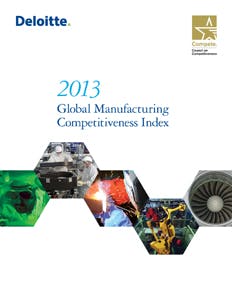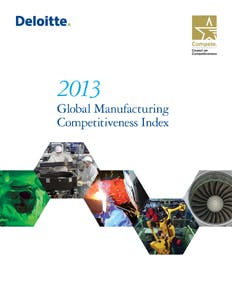Access to talented workers is the top indicator of a country’s manufacturing competitiveness, followed by a country’s trade, financial and tax system, and then the cost of labor and materials, according to the 2013 Global Manufacturing Competitiveness Index report from Deloitte Touche Tohmatsu Limited’s (DTTL) Global Manufacturing Industry group and the U.S. Council on Competitiveness.
“Nothing was more important to CEOs than the quality, availability and productivity of a nation’s workforce to help them drive their innovation agendas,” Craig Giffi, vice chairman, Deloitte United States (Deloitte LLP), said in a prepared statement. Giffi is a consumer and industrial products industry leader, who co-authored the report and led the research-team. “Enhancing and growing an effective talent base remains core to competitiveness among the traditional manufacturing leaders—and increasingly among emerging market challengers as well.”
The report reveals several schisms in competitiveness between established manufacturing players and their emerging counterparts, most notably:
• Traditional manufacturing stalwarts are perceived to have an advantage with respect to talent-driven innovation. More than 85 percent of global executives “strongly agree” or “agree” that the availability of quality skilled talent needed for advanced manufacturing in the United States, Germany and Japan makes those nations highly competitive—while just 58 percent say the same about China and 40 percent say it about India.
• Established manufacturing nations scored far better than emerging manufacturing nations when it came to local economic, trade, financial and tax systems. More than seven in 10 global business leaders “strongly agree” or “agree” that Germany and the United States have an extreme competitiveness advantage based on this criterion, but only 43 percent say the same about India.
• Superior healthcare systems will likely give established manufacturing nations a distinct advantage over emerging players, thanks to their access to quality care and regulatory policies for public health. More than seven in 10 business leaders believe that the healthcare systems in the United States, Germany and Japan make them extremely competitive, but no more than three in 10 say that about China, India and Brazil.
• When looking at labor costs and availability, stalwart manufacturing nations find themselves squarely on the defensive. Almost nine in 10 global executives believe China and India are extremely competitive with respect to the local cost and availability of labor, but fewer than four in 10 believe the same about the United States, Germany and Japan.
• The newest of the emerging superpowers have a long way to go when it comes to supplier networks. Five in 10 executives or fewer “strongly agree” or “agree” that India and Brazil are extremely competitive relative to their supply networks, compared to the eight in 10 or more who say the same thing about the United States, Germany and Japan.
• Emerging manufacturing nations will likely struggle to be competitive in regard to their legal systems. Fewer than four in 10 global business leaders “strongly agree” or “agree” that China, India and Brazil are extremely competitive relative to their legal systems, compared to the more than eight in 10 who feel that way about the United States, Germany and Japan.
• Newer manufacturing players face an uphill battle when it comes to physical infrastructure competitiveness. Fewer than a quarter of business executives “strongly agree” or “agree” that India’s infrastructure makes it extremely competitive, but almost nine in 10 say the United States, Germany and Japan have a strong infrastructure advantage.
“The emerging superpowers in manufacturing will focus on building the advanced manufacturing capabilities and economic and political infrastructures that drive rapid growth and high value jobs for their citizens, forcing 20th century manufacturing powerhouses to fend off the growing strength of more focused global competitors,” Giffi said.
Still, Giffi points out that “manufacturing still matters a great deal for the economic prosperity of 20th century powerhouses—and these nations continue to have enough going for them to stay in the game and even thrive.” To download the 2013 Global Manufacturing Competitiveness Index report, visit www.deloitte.com/globalcompetitiveness.
Related Content:
Manufacturing Index Shows Emerging Nations Surging, While U.S., Germany & Japan Struggle to Keep Pace
Related Links:
www.deloitte.com/globalcompetitiveness



